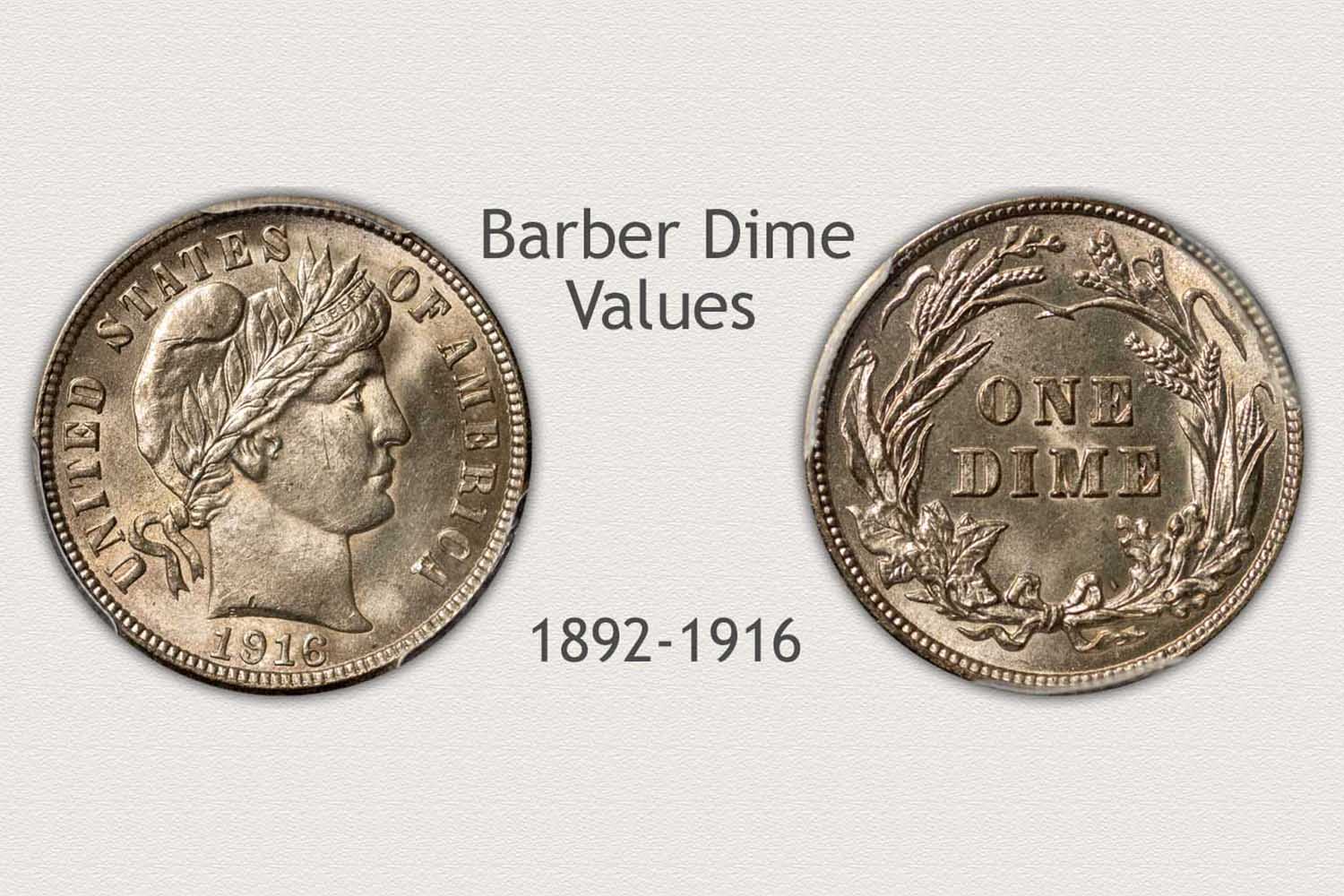
The Ultimate Guide to Barber Coinage: Dimes, Quarters & Half Dollars (1892–1916)
Barber dimes, quarters, and half dollars named for their designer, Charles E. Barber, Chief Engraver of the U.S. Mint—are among the most collected classic U.S. coin series. Struck from 1892 through the mid-1910s in 90% silver, these coins bridged the gap between the Seated Liberty types of the 19th century and the “art medal” renaissance coins of the 20th century (Mercury dime, Standing Liberty quarter, and Walking Liberty half).
For new and advanced numismatists alike, Barber coins offer breadth (three denominations, multiple mints) and depth (varieties, proofs, condition rarities). This guide distills what matters: background and design, how the series is collected, strike and grading nuances, key and semi-key dates by denomination, the most important condition rarities, buying/selling tips, and how to get a fair offer when it’s time to sell a collection.
1) Background, Design & Mints
Designer & Aesthetic.
Charles E. Barber introduced a cohesive obverse design across the dime, quarter, and half dollar in 1892: a classical Liberty head facing right, wearing a Phrygian cap and laurel wreath, with LIBERTY on a small coronet (visible only on the dime). The reverse varies slightly by denomination, but each features a heraldic eagle. While Barber’s work was criticized by many artists for being conservative, the coins were engineered for durability in circulation and consistent production at multiple mints.
Mints & Mintmarks.
- Philadelphia (no mintmark) generally the best struck coins and the main source of proofs.
- New Orleans (O) often weaker strikes; many dates are scarce in high grade.
- San Francisco (S) several low-mintage keys and semi-keys, plus coins that circulated hard in the West.
- Denver (D) appears late in the series (from 1906); many dates are readily available in circulated grades but can be surprisingly tough fully original in AU–MS.
Timeframe.
- Dimes: 1892–1916 (replaced by the Winged Liberty “Mercury” dime in late 1916).
- Quarters: 1892–1916 (replaced by the Standing Liberty quarter in late 1916).
- Half Dollars: 1892–1915 (replaced by the Walking Liberty half in 1916).
Metal & Specs (all three denominations).
- Composition: 90% silver, 10% copper
- Dime: 17.9 mm, 2.5 g
- Quarter: 24.3 mm, 6.25 g
- Half: 30.6 mm, 12.5 g
2) How Collectors Approach the Barber Series
By Denomination. Most collectors start with one denomination (dimes are the least expensive set to tackle), then graduate to quarters and halves.
Date/Mint Sets. The classic challenge is a complete date-and-mintmark run. Each series has notorious stoppers.
Grade Targets.
- Circulated “original gray”: Barber coins wear beautifully; problem-free Fine–VF sets are popular and attainable (except for a few “stoppers”).
- AU/UNC: Far fewer coins survived in high grade, especially from New Orleans and San Francisco. Attractive, original AU–MS examples command strong premiums.
- Proofs: Struck annually at Philadelphia. Proof-only rarities occur in specialized cases (notably the famed 1894-S dime is a special case, see below).
Strike, Luster, and Eye Appeal. Barber coins are notorious for soft strikes particularly on the ear, hair above the forehead, and wreath leaves on the obverse; and eagle’s claws and breast feathers on the reverse. Full, even luster is a major plus; original pastel toning is prized.
3) Grading & Strike Nuances (Read This Before You Buy)
- Dimes: Check the LIBERTY on the coronet (it’s faint on worn coins), hairline detail over the ear, and laurel leaf tips. Reverse: the E Pluribus Unum ribbon and wing/feather separation. In higher grades, look for uninterrupted cartwheel luster and minimal ticks in the open fields.
- Quarters: The hair above the ear and wreath (obverse) and breast feathers (reverse) are strike indicators. The wide fields show marks easily; original skin with soft pastel toning is a positive. Many S-mint coins saw heavy circulation in the West, so strictly problem-free VF/XF examples deserve a premium.
- Half Dollars: The largest canvas means more potential for contact marks. Watch the cheek/jawline, cap and laurel, and reverse shield and feather tips. Weak New Orleans strikes are common; finding a sharply struck O-mint half in AU–MS is a feat.
Cleaning & “Dipping.” Bright, unnatural “white” Barber coins with little skin are often dipped or cleaned. Many collectors pay more for honest, original surfaces even at slightly lower numeric grades.
4) Barber Dimes (1892–1916)
What Makes the Dime Series Special?
Barber dimes are the most approachable of the trio in terms of budget, but the set contains one of the most legendary American coin rarities: the 1894-S Barber dime.
Key Dates & Semi-Keys (Dimes)
- Monumental Rarity:
- 1894-S The “King of Barber Dimes.” A special-situation issue with a tiny mintage (reportedly 24 pieces struck; single-digit survivors known today). This coin sits outside normal set-building; it’s a trophy-level rarity.
- Established Keys / Major Stoppers:
- 1895-O Low mintage and heavy circulation make this the toughest regular-issue New Orleans dime.
- 1896-S Scarce across the grade spectrum; high demand in all collectible grades.
- 1897-O Another O-mint hurdle, especially difficult in VF+ with original surfaces.
- 1901-S One of the toughest San Francisco dimes; hard to locate problem-free.
- Important Semi-Keys / Better Dates:
- 1903-S Often grouped with the keys; a recognized stopper in mid- to high-grade.
- 1892-S, 1892-O, 1894-O Early-series S and O mints that are notably scarcer above VF.
- 1905-O Micro O (variety) A popular mintmark variety prized by specialists.
Condition Rarities (Dimes)
- True Gem (MS65+) Philadelphia and San Francisco coins are much scarcer than price guides suggest; look for fully original luster and a solid strike.
- New Orleans (O) dimes in AU–MS with real skin and decent strikes are significantly tougher than their populations imply; most survivors are either softly struck or “brightened.”
Proof Dimes
Philadelphia proofs exist for every year of the series; many proof sets were broken up. Cameo contrasts and beautifully toned proofs trade at meaningful premiums. Be cautious of coins “market-graded” as proofs if the diagnostics are weak stick with certified examples from top services for expensive pieces.
5) Barber Quarters (1892–1916)
Why Quarters Are the Toughest Set
Many collectors consider Barber quarters the most challenging date-and-mint set in the entire Barber canon. Several brutal low-mintage keys and a long list of semi-keys make for a thrilling (and expensive) chase.
Key Dates & Semi-Keys (Quarters)
- Headline Keys / The Big Four (often cited):
- 1896-S Extremely scarce in any grade. A cornerstone key with tiny surviving populations in Fine+.
- 1897-S Tough across grades; particularly elusive original examples above VF.
- 1901-S A legendary rarity in the series; a true stopper in all grades.
- 1913-S Among the lowest regular-issue mintages of any U.S. quarter of the era; a key date that is deceptively elusive in problem-free mid-grade.
- Other Keys and Important Semi-Keys:
- 1896-O and 1897-O Not on every “Big Four” list, but these O-mints are genuinely tough in collectible condition.
- 1901-O A well-known better date; undervalued relative to difficulty in higher circulated grades.
- 1909-O A favorite semi-key with regional demand; harder than guide numbers in XF/AU.
- Early San Franciscos (e.g., 1892-S, 1893-S, 1894-S) Scarce above VF with original skin due to rough circulation in the West.
- Varieties: 1892-O Micro O is a notable mintmark variety collected alongside the main set by specialists.
Condition Rarities (Quarters)
- Original, problem-free VF–AU quarters especially from San Francisco are far scarcer than populations suggest because so many coins show harsh cleanings, rim bumps, or scratches.
- Mint State quarters with strong strikes (full hair above ear, bold eagle breast feathers) are catalog trophies.
- The 1913-S is notorious for being difficult even in Good–Fine without problems.
Proof Quarters
Proof strikes are available for each year from Philadelphia and often show attractive cameo devices. Light, multicolor album toning is common and desirable. As always, beware of cleaned proofs; look for originality in the mirrors.
6) Barber Half Dollars (1892–1915)
The Workhorse of American Commerce
Barber halves did heavy duty in commerce especially in the South and West—so high-grade survivors are scarce. A single regular-issue key date dominates the series, joined by several condition rarities and one famous mintmark variety.
Key Dates & Semi-Keys (Halves)
- The Classic Key:
- 1904-S Widely recognized as the key to the regular-issue half-dollar set. Tough in all grades, and especially rare in XF–AU with original surfaces. A benchmark date that anchors serious sets.
- Other Important Semi-Keys / Better Dates:
- 1892-O Micro O (variety) The most famous Barber half variety; the mintmark punch is abnormally small. Popular and scarce; strong premiums in every grade.
- 1892-S, 1893-S Early San Franciscos are difficult problem-free above VF due to heavy circulation.
- 1896-O, 1896-S Notorious for soft strikes; genuinely scarce in pleasing AU–MS.
- 1897-O, 1897-S Both better dates; original examples in XF+ don’t linger.
- 1903-O, 1905-O Underrated semi-keys, particularly tough in strictly original AU.
- 1913-S, 1914-S Late-series S-mints with persistently strong demand; originals in AU and better are true condition rarities.
Condition Rarities (Halves)
- New Orleans Mint (O-mint) halves in AU–MS with legitimate luster and non-dipped skin are hard to source due to weak strikes and heavy circulation.
- 1904-S is a headline condition rarity above VF; certified AU coins—especially those with attractive toning—sell immediately.
- Philadelphia coins can be well struck and lustrous but are often discounted relative to the same grade from branch mints; smart collectors cherry-pick P-mint halves with outstanding eye appeal.
Proof Halves
Proof Barber halves exist for each year of the series. High-grade, cameo proofs with original toning are centerpieces in Barber type sets. Many proofs were mishandled during the mid-20th century; originality is paramount.
7) Varieties, Errors & Collector “Gotchas”
- Micro O Mintmarks (1892-O quarter and half; 1905-O dime) Attractive, well-documented varieties. Be sure you know diagnostics or buy certified pieces, as counterfeit micro mintmarks exist.
- Repunched Mintmarks (RPMs) & Doubled Dies Collected within advanced sets; value depends on visibility and popularity in the specialty literature.
- Counterfeits & Altered Dates Common on key-date dimes (e.g., altered 1901-S, or added “S” mintmarks) and on 1896-S/1897-S/1901-S quarters. Rely on reputable third-party grading for expensive keys.
- Cleaning/Whizzing Heavily cleaned Barbers are everywhere; the series’ large, open fields invited mishandling. Favor coins with undisturbed patina, even if the numeric grade is modest.
8) Building a Smart Barber Set (Strategy & Budgeting)
Define Your Target Grade.
- Collector-friendly: Fine–VF with even, original gray toning; attractive and affordable.
- Showpiece: XF–AU for type; MS for selected common dates to showcase the design in full detail.
- Investment-grade: AU–MS with superb eye appeal and CAC/plus designations where available; this is where true scarcity skyrockets.
Prioritize Keys Early.
The best time to buy Barber keys is before you finish the common dates. Spreading the cost out prevents “sticker shock.” For dimes, don’t plan on 1894-S it’s an outlier trophy. For quarters and halves, build around 1896-S/1897-S/1901-S/1913-S quarters and the 1904-S half.
Buy the Coin, Not the Holder.
With Barber coinage, originality trumps the number on the slab. Many coins at the same grade look radically different in character and long-term desirability. When possible, view coins in hand or insist on high-resolution, true-color images.
Provenance & Pedigree.
Coins from old collections with stable, natural toning often command deserved premiums. Barber specialists track pedigrees for the finest examples.
9) Market Dynamics: Why Some Dates Feel “Tougher” Than the Books
- True Survivorship: Official mintages don’t tell the whole story. Western S-mints circulated hard; countless coins were later melted.
- Strike Bias: O-mint coins can be numerically high but visually soft; eye-appealing, sharply struck pieces are genuinely scarce and thus more valuable than the grade alone suggests.
- Taste Cycles: Over the last two decades, demand has shifted toward original skin and away from bright, dipped surfaces. Barber coins with natural patina are firmly in favor.
10) Quick Reference: Keys & Semi-Keys by Type
Barber Dimes (1892–1916)
Key: 1894-S (ultra-rarity; special issue)
Major Keys: 1895-O, 1896-S, 1897-O, 1901-S
Important Semi-Key: 1903-S
Notable Variety: 1905-O Micro O
Condition Rarities: O-mint dimes in AU–MS with strong strikes and original luster; gem P/S-mints.
Barber Quarters (1892–1916)
Big Keys: 1896-S, 1897-S, 1901-S, 1913-S
Other Difficult Dates: 1896-O, 1897-O, 1901-O, 1909-O; early S-mints in higher grades
Notable Variety: 1892-O Micro O
Condition Rarities: Problem-free VF–AU S-mints; MS examples with bold eagle breast feathers.
Barber Halves (1892–1915)
Key: 1904-S
Important Semi-Keys: 1892-S, 1893-S, 1896-O, 1896-S, 1897-O, 1897-S, 1903-O, 1905-O, 1913-S/1914-S
Notable Variety: 1892-O Micro O
Condition Rarities: AU–MS O-mints with original skin; 1904-S above VF.
(Note: The above lists focus on what collectors consistently experience in the real market—availability in problem-free condition rather than just mintage counts.)
11) Selling Barber Coins: Getting a Fair Offer
Barber coins run the gamut from modest common dates to five- and six-figure rarities. Whether you’re thinning a collection or handling an estate, transparent evaluation and up-to-date market context make all the difference. Consider:
- Certified vs. Raw: Keys and expensive coins generally sell more easily (and at stronger prices) when certified by PCGS or NGC. For raw coins, high-quality images and trustworthy grading opinions are essential.
- Originality Premium: Problem-free, original-skin coins deserve more. Don’t accept common-date AU prices for a genuinely scarce, well-struck O-mint with great eye appeal.
- Whole-Collection Strategy: Sometimes selling a complete set attracts premium pricing compared with piecemeal sales especially if the set is well matched for originality and toning.
12) A Trusted Place to Get an Estimate or Offer
When you want straight, market-based guidance whether on a handful of better dates or a full Barber set—turn to CashForCoins.net. They evaluate both numismatic merit and real-world demand, not just melt value. If you’re looking for a fair estimate or offer on Barber coins (or any U.S. coin collection), including estate holdings, CashForCoins.net is a great first call: knowledgeable, responsive, and transparent.
13) Final Thoughts
The Barber dime, quarter, and half dollar series offer a lifetime of study. Between strike idiosyncrasies, genuine key-date hurdles, and the hunt for originality, these sets reward patience and connoisseurship. Start with a realistic plan, learn the look of original surfaces, prioritize tough dates early, and most of all enjoy the chase. Few areas of U.S. numismatics feel as “classic” in the hand as an honest, original Barber coin.


